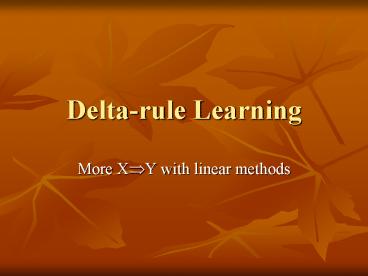Delta-rule Learning - PowerPoint PPT Presentation
1 / 17
Title:
Delta-rule Learning
Description:
Delta-rule Learning More X Y with linear methods Widrow-Hoff rule/delta rule Taking baby-steps toward an optimal solution The weight matrix will be changed by small ... – PowerPoint PPT presentation
Number of Views:188
Avg rating:3.0/5.0
Title: Delta-rule Learning
1
Delta-rule Learning
- More X?Y with linear methods
2
Widrow-Hoff rule/delta rule
- Taking baby-steps toward an optimal solution
- The weight matrix will be changed by small
amounts in an attempt to find a better answer. - For an autoassociator network, the goal is still
to find W so that W.x x. - But approach will be different
- Try a W, compute predicted x, then make small
changes to W so that next time predicted x will
be closer to actual x.
3
Delta rule, cont.
- Functions more like nonlinear parameter fitting -
the goal is to exactly reproduce the output, Y,
by incremental methods. - Thus, weights will not grow without bound unless
learning rate is too high. - Learning rate is determined by modeler - it
constrains the size of the weight changes.
4
Delta rule details
- Apply the following rule for each training row
- DWh (error)(input activations)
- DWh(target - input)inputT
- Autoassociation
- DWh(x - W.x) xT
- Heteroassociation
- DWh(y - W.x) xT
5
Autoassociative example
- Two inputs (so, two outputs)
- 1,.5?1,.5 0,.5 ? 0,.5
- W 0,0,0,0
- Present first item
- W.x 0,0 x - W.x 1, .5 error
- .1 error xT .1,.05,.05,.025, W
.1,.05,.05,.025 - Present first pair again
- W.x .125, .0625 x - W.x .875, .4375
error - .1 error xT .0875,.04375,. 04375,.021875,
so W .1875,.09375,.09375,.046875
6
Autoassociative example, cont.
- Continue by presenting both vectors 100 times
each (remember - 1, .5, 0, .5) - W .9609, .0632, .0648, .8953
- W.x1 .992, .512
- W.x2 .031, .448
- 200 more times
- W .999, .001, .001, .998
- W.x1 1.000, .500
- W.x2 .001, .499
7
Capacity of autoassociators trained with the
delta rule
- How many random vectors can we theoretically
store in a network of a given size? - pmax lt N where N is the number of input units
and is presumed large. - How many of these vectors can we expect to learn?
- Most likely smaller than the number we can expect
to store, but the answer is unknown in general.
8
Heteroassociative example
- Two inputs, one output
- 1,.5?1 0,.5 ?0 .5,.7 ?1
- W 0,0
- Present first pair
- W.x 0,0 x - W.x 1, .5 error
- .1 error xT .1, .05, so W .1, .05
- Present first pair again
- W.x .1, .025 x - W.x .9, .475 error
- .1 error xT .09, .0475, so W .19, .0975
9
Heterassociatve example, cont.
- Continue by presenting all 3 vectors 100 times
each (remember - right answers are 1, 0, 1) - W .887, .468
- Answers 1.121, .234, .771
- 200 more times
- W .897, .457
- Answers 1.125, .228, .768
10
Last problem, graphically
11
Bias unit
- Definition
- An omnipresent input unit that is always on and
connected via a trainable weight to all output
(or hidden) units - Functions like the intercept in regression
- As a practice, a bias unit should nearly always
be included.
12
Delta rule and linear regression
- As specified the delta rule will find the same
set of weights that linear regression (multiple
or multivariate) finds. - Differences?
- Delta rule is incremental - can model learning.
- Delta rule is incremental - not necessary to have
all data up front. - Delta rule is incremental - can have
instabilities in approach toward a solution.
13
Delta rule and the Rescorla-Wagner rule
- The delta rule is mathematically equivalent to
the Rescorla-Wagner rule offered in 1972 as a
model of classical conditioning. - DWh(target - input)inputT
- For Rescorla-Wagner, each input treated
separately. - DVAa(l - input)1 -- only applied if A is
present - DVBa(l - input)1 -- only applied if B is
present - where l is 100 if US, 0 if no US
14
Delta rule and linear separability
- Remember the problem with linear models and
linear separability. - Delta rule is an incremental linear model, so it
can only work for linearly separable problems.
15
Delta rule and nonlinear regression
- However, the delta rule can be easily modified to
include nonlinearities. - Most common - output is logistic transformed
(ogive/sigmoid) before applying learning
algorithm - This helps for some but not all nonlinearities
- Example helps with AND but not XOR
- 0,0 -gt 0 0,1-gt0 1,0-gt0 1,1-gt1 (can learn
cleanly) - 0,0 -gt 0 0,1-gt1 1,0-gt1 1,1-gt0 (cannot learn)
16
Stopping rule and cross-validation
- Potential problem - overfitting the data when too
many predictors. - One possible solution is early stopping - dont
continue to train to minimize training error but
stop prematurely. - When to stop?
- Use cross-validation to determine when.
17
Delta rule - summary
- A much stronger learning algorithm than
traditional Hebbian learning. - Requires accurate feedback on performance.
- Learning mechanism requires passing feedback
backward through system. - A powerful, incremental learning algorithm, but
limited to linearly separable problems































